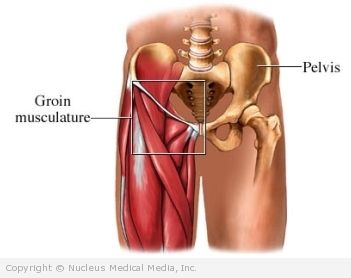(Adductor Strain; Groin Pull; Pulled Groin; Pulled Groin Muscle; Strain, Adductor; Strain, Groin)
Groin Strain – Definition
A groin strain is a partial tear of the small fibers of the adductor muscles. The adductors are a group of three muscles located on the inner side of the thigh. They start in the groin area and run down the inner thigh to attach to the inner side of the knee.
Groin Strain – Causes
A groin strain can be caused by:
- Stretching the adductor muscles beyond the amount of tension that they can withstand
- Suddenly putting stress on the adductor muscles when they are not ready for the stress
- Using the adductor muscles too much on a certain day
- Getting direct blow to the adductor muscles
Groin Strain – Risk Factors
These factors increase your chance of developing a groin strain. Tell your doctor if you have any of these risk factors:
- Participation in sports that require bursts of speed, such as:
- Running
- Hurdles
- Long jump
- Basketball
- Soccer
- Football
- Hockey
- Rugby
- Fatigue
- Tight groin muscles
- Overexertion
- Cold weather
Groin Strain – Symptoms
Symptoms include:
- Pain and tenderness in the groin area
- Stiffness in the groin area
- Weakness of the adductor muscles
- Bruising in the groin area (if blood vessels are broken)
- Popping or snapping sensation as the muscle tears (possibly)
Groin Strain – Diagnosis
The doctor will ask about your symptoms, medical history, physical activity, and the injury. Your thigh will be examined for:
Tenderness and/or bruising directly over the adductor muscles
Pain or weakness when contracting the adductor muscles, particularly against resistance
Muscle strains are graded according to their severity:
Grade 1
- Stretching with some microtearing of muscle fibers
- Recovery: 2 weeks
Grade 2
- Partial tearing of muscle fibers
- Recovery: 1-2 months
Grade 3
- Complete tearing (rupture) of muscle fibers
- Recovery: three months
For severe groin strains, you may have an MRI scan. If you’re an athlete, your doctor may have this test done to help determine how long your recovery will be.
Groin Strain – Treatment
Treatment depends on how severe the strain is. It usually includes:
- Rest — Do not do activities that cause pain. If normal walking hurts, shorten your stride. Do not play sports until the pain is gone.
- Cold — Apply ice or a cold pack to the groin area for 15-20 minutes, four times a day, for several days after the injury. Wrap the ice or cold pack in a towel. Do not apply the ice directly to your skin.
- Pain relief medications — Ask your doctor which over-the-counter medication is right for you. Topical pain medicines (eg, creams, patches) applied to the skin are another option.
- Compression — Wear an elastic compression bandage (eg, Ace bandage) around your upper thigh to prevent swelling. Do not wrap the bandage too tight.
- Elevation — For the first 24 hours, keep your leg higher than your heart to minimize swelling.
- Heat — Use heat only when you are returning to physical activity. Then use it before stretching or getting ready to play sports.
- Stretching — When the acute pain is gone, follow your doctor’s guidelines for stretching. Stay within pain limits. Stretch several times each day.
- Strengthening — Begin strengthening exercises for your adductor muscles as recommended by a healthcare professional.
Check with your doctor before returning to activity.
Groin Strain – Prevention
To help reduce your chance of getting a groin strain, take the following steps:
- Keep your adductor muscles strong to absorb the energy of sudden physical stress
- Warm-up before stretching your adductor muscles
- Learn the proper technique for exercises and sports

